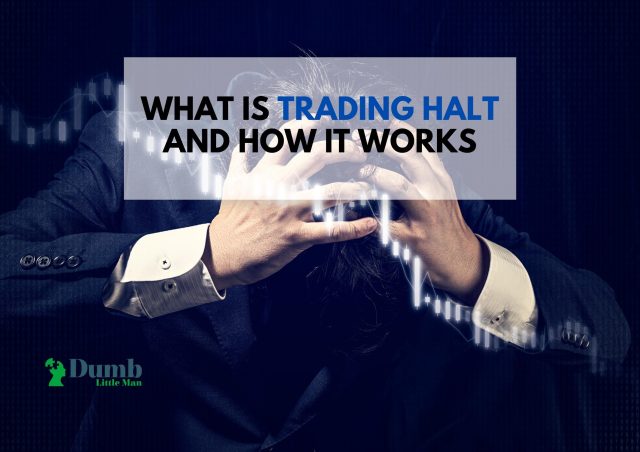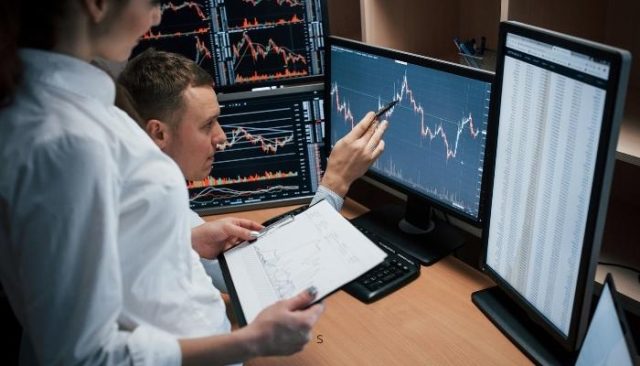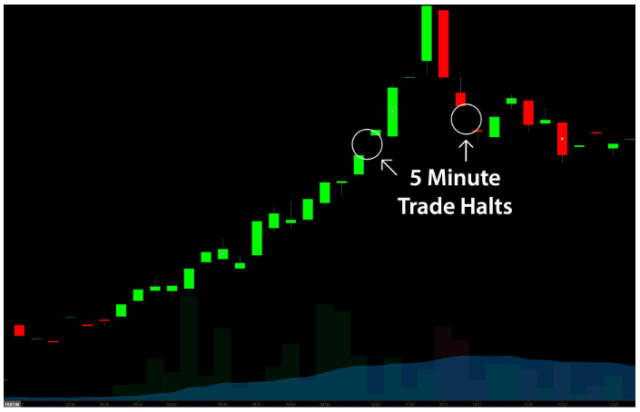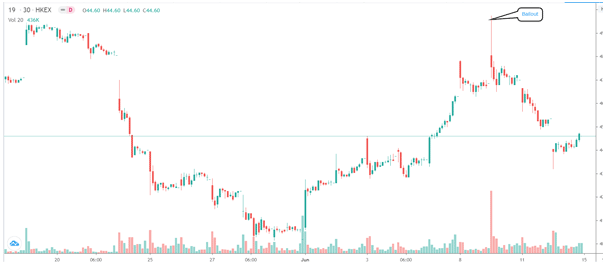What Is Trading Halt And How They Work – Beginners Guide (2024)
By Jordan Blake
January 10, 2024 • Fact checked by Dumb Little Man

Want to jump straight to the answer? The best stock brokers for traders are Tradestation and Tradier
The #1 Stock and Forex Trading Course is Asia Forex Mentor
Have you ever tried to trade stock only to discover it was unavailable then? If so, you are not by yourself. In the stock market, delays and trading halts are frequent occurrences.
A trading halt is among the most upsetting things that might happen during the day. The stock exchange implements a trading halt, pausing all trading in the securities for a predetermined amount of time. The reasons for the pause determine the duration. A trade stop is intended to suspend trading in the face of a significant order imbalance and give the market time to process the news.
This article will provide all the information and knowledge you need to understand a trading halt, how it protects investors, its importance, and how you can benefit immensely from it.
What is a Trading Halt

A brief cessation of trading for a specific security or securities at one exchange or across several exchanges is known as a “trading halt.” The security price or an index may have changed sufficiently quickly to warrant a halt following exchange rules.
Trading may be suspended in anticipation of news announcements to address an order imbalance due to a technical issue, because of regulatory concerns, or for any other reason. Open orders may be canceled, and options may still be exercised when a trading halt is in place.
A trading halt differs from a Securities and Exchange Commission-ordered trading suspension (SEC). To protect investors and the general public's interest, the SEC is authorized by U.S. securities law to halt public trading in any stock for a maximum of 10 days.
How Trading Halts Work

In the uncommon event that a stock exchange announces a ban on trading a specific share, this is known as a “stock halt.” At this phase of the trading process, brokers won't be permitted to buy or sell the security for themselves or everyday investors like us.
An exchange can only announce a trading stop in a few predetermined circumstances, and specific guidelines must be fulfilled before the stock can resume trading. Additionally, the whole exchange may cease trading in extraordinary circumstances. The primary goal is to match the buyers and sellers of the specific security to ensure efficient trade execution and balance the demand and supply of the stock.
The seamless trade operation is in NASDAQ's and NYSE's best interests. It serves as the global exchange community's philosophy. To prevent investors from experiencing substantial financial losses, exchanges can freeze or halt the trading of a particular stock when there is important news regarding securities that could cause trade orders to become unbalanced. It's mainly done to prevent investors from blaming exchanges for such significant losses.
The Securities and Exchange Commission (SEC) is empowered by federal U.S. securities legislation to impose up to a 10-day trading halt on publicly traded companies. If the SEC thinks that ongoing stock trading puts the investing public in danger, it will exercise this authority. It usually uses this authority when a publicly traded firm has neglected to submit required periodic reports, such as quarterly or annual financial statements.
Examples of Trading Halts

Several trading halts could occur during an average trading session, making them frequent. Here are a few actual instances of trading halts:
The Green Bright Corp (BGXX)
The price of BGXX stock rose from $11.84 to $12.80 in under five minutes at the end of May 2022. A LUDP pause that prevented trades for 10 minutes was brought about by the top price's 11.5% movement.
The DryShips Inc. (DRYS)
In one week in 2016, the share price of DryShips rose from $5.10 to about $120. In the absence of more information from the company explaining why the stock was moving so wildly, Nasdaq imposed a T12 halt.
T12 halts, which are requests from Nasdaq for more information from the company, frequently happen when a stock increases sharply for no apparent reason. The DRYS pause was in effect for multiple trading sessions.
The Financial PCSB (PCSB)
To give investors time to process the announcement that Brookline Bancorp will buy PCSB, T1 and T2 trading halts on the stock were implemented in May 2022.
The Pros and Cons of Trading Halts
Pros
- Allow all-inclusive participation in the marketplace
- It removes arbitrage opportunities
- It allows all marketplaces or exchanges to receive news concurrently
- It shields investors from suffering significant financial losses
Cons
- Losses due to interested investors losing the chance to trade the shares could result from a protracted halt
- The investor loses money since they cannot purchase the stock at meager prices and profit from the subsequent increase in stock price
What do Trading Halts mean for Investors

The specific securities won't be able to trade on stock exchanges when trading is stopped. It will remain on the list until the halt is lifted. Brokers and individual investors won't be allowed to buy or sell securities in that specific stock for a set amount of time.
Additionally, in rare cases, stock values will typically plummet after a T12 category halt is lifted. A T12 halt is applied to stock that rises abruptly without any genuine reason. As a result, the market will correct itself following the stop, which will cause prices to decline.
In any case, closely monitor the market's behavior following the stop. Price changes frequently include several overreactions. If you invested in positive news, you can try to sell close to the high and then repurchase your shares when the euphoria subsides.
Reasons for Stock Halts

Trading halts can be either regulatory or non-regulatory.
Regulatory halts occur when a corporation is due to announce major market-moving news, such as earnings reports or warnings, mergers, acquisitions, or government decisions. Modifications to the corporate board or organizational structure pending recommendations from the FDA advisory board.
Companies will approach the exchanges directly to request a regulatory freeze. The stop is intended to give investors and institutions time to assess and process the news more logically before deciding on the next steps. These halts can continue for a few minutes or several hours.
Non-regulatory trading halt act as speed bumps, activated when a stock exceeds a price percentage level that moves too swiftly in one direction. These interruptions, often known as “circuit breakers,” are designed to stop the process and balance the order imbalance.
Best Stock and Forex Trading Course

Ezekiel Chew has been a professional Forex trader and mentor in the financial markets since 2005. He is the founder and CEO of Asia Forex Mentor, a company that provides Forex trading education and mentorship to individuals around the globe.
Ezekiel is known for his unique and highly effective Forex trading methods, which are backed by mathematical probability. He has helped thousands of students worldwide achieve financial freedom through Forex trading. His core program, “AFM PROPRIETARY ONE CORE PROGRAM,” is a complete program that covers everything from beginner to advanced and has been used by banks and trading institutions worldwide.
So, if you are looking forward to learning from one of the best in the business, Ezekiel Chew’s Asia Forex Mentor program is worth checking out. Sign-up for his course now to kick start your forex trading career.
| RECOMMENDED TRADING COURSE | REVIEW | VISIT |
|---|---|---|
 | #1 Forex, Crypto and Stocks trading course. Ranked most comprehensive by Investopedia and Best by Benzinga. Free to Try! |  |
Best Stock Brokers
| Broker | Best For | More Details |
|---|---|---|
 | Advanced Traders Read Review | securely through Tradestation website |
 | Intuitive Platforms Read Review | securely through Tradier website |
 | Powerful Services at a Low Cost | securely through Tradezero website |
 | Professional Forex Traders Read Review | securely through Interactive Brokers website |
Conclusion: Trading Halts

Trading halts are essential tools that exchanges use to prevent anybody with insider information from profiting unfairly and to address any unusual and technical trading concerns. If you own the stock that has been halted, trading halts can be unsettling, but they can also be profitable. Keep your emotions from taking over the issue.
When a halt happens, do your homework, determine why the stock cannot be traded, and evaluate the circumstances. Even if you don't own the stock whose trading has been paused, opportunities can arise from trading halts.
Most news is released during the institutional investor-dominated premarket and after-hours trading sessions, providing them with the earliest opportunity to trade the news. However, during a mid-session trading halt, not even the institutional players are allowed to trade. Investigate the causes of the halts and take informed judgments to convert them into profitable trading opportunities when trading resumes.
Trading Halts FAQs
Is Trading halts a good thing?
Specific stocks will experience a halt in trading, which will make investors feel uneasy and apprehensive. Halts in trading can have both good and bad effects. As a trader, it is your responsibility to seize the opportunity and scan the potential.
The market's volatility is an excellent incentive to start playing the game. When amid a trading stoppage, keep in mind to evaluate the dangers, get a general perspective, and work to make it profitable for you.
Is halt trading legal?
Yes. When the SEC judges that a trading suspension is necessary for the public interest and the protection of investors, the federal securities laws permit the SEC to halt trading in any stock for up to 10 trading days.
Jordan Blake
Jordan Blake is a cultural commentator and trending news writer with a flair for connecting viral moments to the bigger social picture. With a background in journalism and media studies, Jordan writes timely, thought-provoking content on everything from internet challenges and influencer scandals to viral activism and Gen Z trends. His tone is witty, observant, and sharp—cutting through the noise to bring readers the “why” behind the “what.” Jordan’s stories often go deeper than headlines, drawing links to pop culture, identity, and digital behavior. He’s contributed to online media hubs and social commentary blogs and occasionally moderates online panels on media literacy. When he’s not chasing the next big trend, Jordan is probably making memes or deep-diving into Reddit threads. He believes today’s trends are tomorrow’s cultural history—and loves helping readers make sense of it all.













